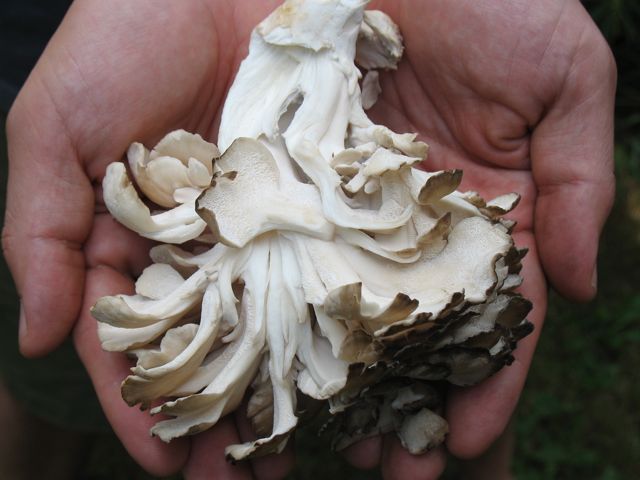
sauces, l
(article, Kelly Myers)
The maitake mushroom is as beautiful as one of its other names, hen of the woods. I would I like to find one in its native habitat, growing at the base of a tree. This clustered mushroom looks like a cross between an open-faced flower and a speckled chicken. But instead of the chicken’s blacks and whites, the maitake is colored with elegant creams and grays. [[block(sidebar). h1.Featured recipes]] What, exactly, does one do with a maitake? I can answer only as a cook. (Notice that I did not identify myself as a mycologist or a medical researcher. Look elsewhere for those perspectives. There is, for instance, much interest in the maitake’s purported cancer-fighting properties, especially in Japan.) I have not tasted wild maitake, but the cultivated version alone possesses a pantry’s worth of flavors and texture. Inhale deeply. Fresh maitake smell of moss, yeast, and damp earth. They taste faintly of smoke, nuts, and minerals. If I had to compare the earthy maitake to any other food, I would say they offer similar satisfactions to those found in good meats and breads. [%image reference-image float=right width=400 caption="A fresh maitake, or hen of the woods, in hand."] Although found wild in Japan and the northeastern United States, almost all maitake you see for sale have been cultivated. To grow them, my friend Maks, who sells maitake and other mushrooms at the People’s Farmers' Market here in Portland, starts with a compressed sawdust log that contains millet and an injection of maitake spores. The maitake’s many petals tenderize when cooked, but retain a pleasant bite. This holds true whether you serve maitake grilled, roasted, sautéed, or, as Maks suggests, torn apart into small pieces as an addition to scrambled eggs. At the Portland Farmers' Market, Springwater Farms sells maitake and other mushrooms. The last time I visited their stall, the farmers had set out samples of maitake sautéed in butter with kernels of sweet corn and fresh onion. It was sweet, savory, earthy, and crazy good. I couldn’t discern whether the the corn was complementing the mushrooms or vice-versa. h3. Mushrooms, grilled When grilled, this versatile mushroom goes well with any number of sauces. My list includes aïoli, a warm salsa rossa of tomatoes and red bell peppers, and pine-nut-and-herb salsa. [%image sauces float=left width=400 caption="A grilled maitake served with warm salsa rossa and a pine-nut-and-herb salsa."] You can also simply toss the hot grilled mushrooms with soft butter that has been mashed in a bowl with salt, pepper, and garlic paste, or with chile powder and lime juice. The grilling process is incredibly easy. First, build a fire of mesquite charcoal or hardwood. Once most of the charcoal has caught fire, burned, and turned white with ash, distribute the coals so that the center of the grill is hot and the sides are medium to low. While you wait for the coals to burn, brush any debris from the mushrooms. If the maitake are large, pull them into pieces about the size of your fist. (Slicing maitake makes them shred, so don't take a knife to them.) Use your hands to toss the mushrooms in a bowl with salt and pepper and olive oil. (Be careful not to break the mushrooms apart.) Place the seasoned mushrooms over moderate, indirect heat, closer to the sides of the grill. Grill over moderate heat with the lid on and the vents partway open, so it smokes a bit. Turn every three or four minutes, grilling each side until the mushrooms start to brown and caramelize. Avoid charring the mushrooms excessively. Serve while still warm with an additional drizzle of olive oil, butter, or any of the sauces mentioned above. All these same condiments, of course, go just as well with anything else you choose to grill, such as steaks, fish, chicken, corn, or potatoes. For a celebratory dinner, invite guests, prepare two or three sauces of different colors, and serve with an entire groaning board of grilled foods: pork sausages, sweet corn, chicken, new potatoes, and bread. Fill out the table with autumnal plums, grapes, and pears. It's the perfect way to introduce the elegant-yet-earthy hen of the woods to all your friends. p(bio). Kelly Myers is a chef and writer in Portland, Oregon. She is also the co-director of Market Chefs, an organization dedicated to inspiring and teaching consumers to cook local foods.

sauces, l

reference-image, l